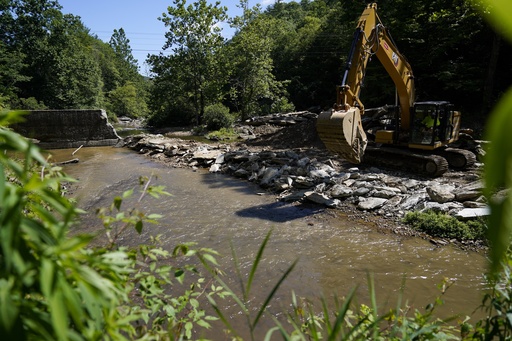In Boone, North Carolina, the Shulls Mill Dam is being removed from the Watauga River in efforts to restore its natural flow after nearly 200 years of confinement. The removal of this privately-owned hydropower dam is expected to benefit recreational activities like rafting, kayaking, and tubing, as well as the eastern hellbender salamander, an ancient and unique species in decline due to habitat loss.
Andy Hill, a Watagua Riverkeeper with MountainTrue, highlighted the importance of the hellbender as a keystone species requiring specific habitat conditions, such as clear, clean, cold, and oxygenated water, all of which will be improved by the dam removal.
Removing aging structures like the Shulls Mill Dam is part of a national trend to enhance biodiversity, water quality, and flood protection through river restoration projects, which have received a substantial funding boost from the recent bipartisan infrastructure bill. Federal agencies, including the U.S. Fish and Wildlife Service, have allocated over $2 billion for maintaining, repairing, and removing dams and barriers, with a significant portion already spent on various projects.
The wildlife service has announced plans to award grants for dam removal projects in 29 states, with a focus on improving aquatic connectivity and restoring river habitats. States like North Carolina and Michigan have also allocated funds for dam removals to mitigate risks to human life and property, enhance ecological benefits, and improve water quality.
The removal of dams has proven to benefit aquatic species, particularly migrating fish, by improving water temperatures, oxygen levels, and habitat for various aquatic life forms. While some large dam systems are being removed, many projects focus on smaller dams that obstruct natural river systems and threaten biodiversity.
In various states, dam removal projects are underway to restore river habitats, support endangered species, enhance flood protection, and improve water quality. These efforts aim to rewild and renaturalize river ecosystems, allowing for the return of native species and promoting ecological balance.
However, there are opposing views on dam removal, especially regarding larger structures, with concerns about economic impacts such as job losses and water source reductions. Advocates argue that dam removal is crucial for restoring river ecosystems, improving aquatic connectivity, and supporting biodiversity.
In North Carolina, where dam removals have been well received, advocates have already observed cleaner water and increased fish population in parts of the river previously disrupted by dams. The removal of the Shulls Mill Dam is expected to create better habitat conditions for the hellbender salamanders living in the area, leading to long-term ecological improvements.
Overall, the removal of dams like Shulls Mill Dam represents a significant step towards restoring natural river systems, supporting wildlife conservation efforts, and promoting ecological sustainability for future generations.
